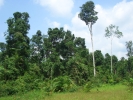 The government of Bangladesh has extended to 2022 the deadline for a ban on cutting down trees at the country’s natural forests, a measure aimed at protecting biodiversity. Just over 10% of Bangladesh’s land area is covered by forests (871,000 ha), 30% of which are primary forests. Just under 25% of the country’s forests are owned by local and indigenous communities, 10% are privately owned and the remainder are state-owned. Less than 4 percent of Bangladesh's original habitats remain, and virtually none of these are rainforest. Many of Bangladesh's 5,000 species of plants and 1,500 species of vertebrates are highly threatened. Several species have disappeared from the country in recent years.
The government of Bangladesh has extended to 2022 the deadline for a ban on cutting down trees at the country’s natural forests, a measure aimed at protecting biodiversity. Just over 10% of Bangladesh’s land area is covered by forests (871,000 ha), 30% of which are primary forests. Just under 25% of the country’s forests are owned by local and indigenous communities, 10% are privately owned and the remainder are state-owned. Less than 4 percent of Bangladesh's original habitats remain, and virtually none of these are rainforest. Many of Bangladesh's 5,000 species of plants and 1,500 species of vertebrates are highly threatened. Several species have disappeared from the country in recent years. Deforestation of the foothills for fuelwood (fuelwood provides more than 60 percent of the country's energy) may contribute to periodic floods that cause widespread misery to people living in the flood plains of the Ganges-Brahmaputra system, which covers about 75 percent of the country.
Forest clearing has led to increased conflicts between wildlife and people. During a four-month period in 1997, elephants killed 30 people and injured over 100 as they sought food, which had become scarce due to forest clearing for agriculture. Subsistence agriculture is widespread in Bangladesh.
Forest clearing has led to increased conflicts between wildlife and people. During a four-month period in 1997, elephants killed 30 people and injured over 100 as they sought food, which had become scarce due to forest clearing for agriculture. Subsistence agriculture is widespread in Bangladesh.
A regular Cabinet meeting, chaired by Prime Minister Sheikh Hasina, on Monday approved the proposal submitted by the Ministry of Environment and Forests. Cabinet Secretary Md Shafiul Alam later told reporters that the ministry had proposed extending the ban until 2025. “But the meeting decided to extend it until 2022.”
The deadline on the ban earlier ended on Dec 31 last year. Alam said the new extended deadline would be considered to have been in effect from Jan 1 this year.
The deadline on the ban earlier ended on Dec 31 last year. Alam said the new extended deadline would be considered to have been in effect from Jan 1 this year.


